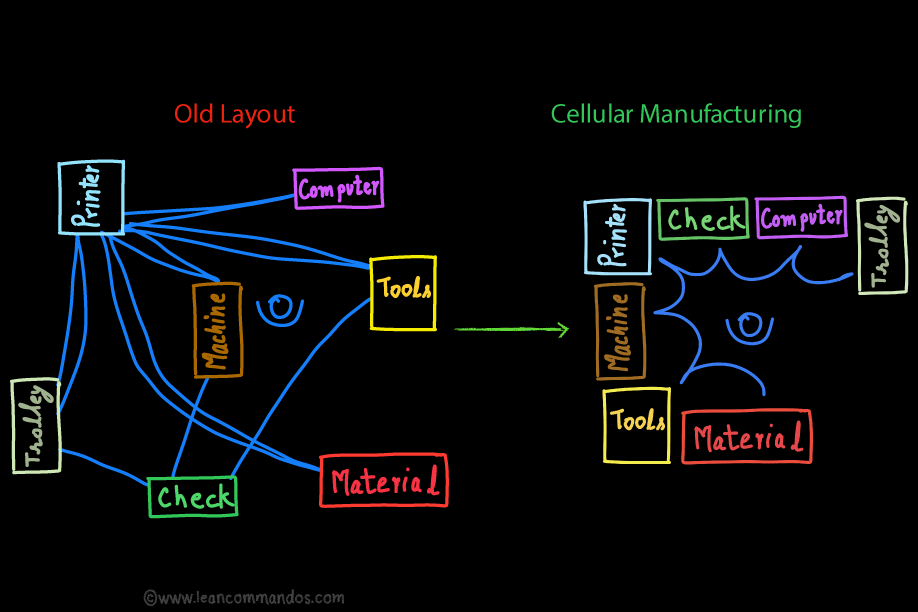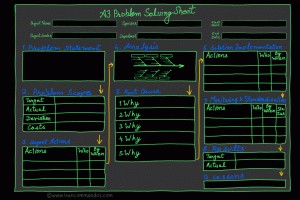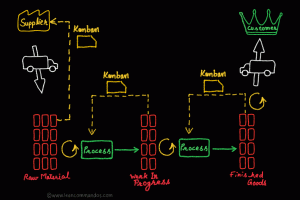Introduction
Cellular Manufacturing is a strategic approach to Lean management that streamlines workflow and increases efficiency in production environments. By organizing workstations into a cell that processes parts in a continuous flow, this method maximizes value creation while minimizing waste.
History and Development
Originating from the Toyota Production System, Cellular Manufacturing revolutionized the traditional assembly line. This approach evolved as a means to reduce the movement of workers and materials, decrease product handling, and improve quality and productivity.
Key Principles
The core of Cellular Manufacturing lies in its layout design, work processes, and the cellular workforce. The layout is designed to minimize waste in the movement of materials and products, processes are streamlined to reduce wait times between operations, and the workforce is cross-trained to perform multiple tasks within the cell.
When to Use the Tool

Implement Cellular Manufacturing when looking to reduce lead times, improve quality, and increase flexibility in production. It is ideal for environments with a high product mix and varying customer demand.
How It Works
Cellular Manufacturing, at its core, reimagines the traditional production line by organizing workstations into interconnected cells. This approach ensures that parts move seamlessly from one processing step to the next, minimizing wait times and eliminating queues between operations. By strategically arranging machines and workstations, typically in a U-shaped configuration, Cellular Manufacturing optimizes communication among workers and minimizes unnecessary movement within the cell.
The process begins with careful layout design, where the physical arrangement of equipment and workstations is meticulously planned to minimize waste in material movement and streamline the production flow. Each cell is tailored to the specific needs of the production process, with a focus on reducing lead times and enhancing flexibility to adapt to changing customer demands.
Within the cell, work processes are streamlined to eliminate bottlenecks and inefficiencies. Workers are cross-trained to perform multiple tasks, ensuring flexibility and agility in responding to varying production requirements. This cross-training also enhances employee engagement and morale by providing opportunities for skill development and task variety.
Communication within the cell is paramount. With workers operating in close proximity, issues can be quickly identified and addressed, leading to faster problem resolution and improved quality control. Moreover, the collaborative environment fosters a sense of teamwork and shared responsibility for the cell’s performance.
One of the key advantages of Cellular Manufacturing is its ability to facilitate continuous flow production. Unlike traditional batch processing, where parts are produced in large quantities before moving to the next stage, Cellular Manufacturing enables smaller, more frequent production runs. This approach reduces inventory levels and minimizes the risk of overproduction, leading to significant cost savings and improved responsiveness to changes in demand.
Overall, Cellular Manufacturing offers a holistic approach to production optimization, combining efficient layout design, streamlined processes, and a flexible, cross-trained workforce. By embracing this Lean methodology, organizations can achieve significant improvements in productivity, quality, and customer satisfaction, positioning themselves for long-term success in today’s dynamic market environment.
Benefits
Benefits of Cellular Manufacturing include reduced setup time, lower inventory levels, improved employee morale due to a variety of tasks, better quality control, and increased responsiveness to changes in demand.
Common Mistakes and Pitfalls
Common pitfalls include designing cells without considering the variability in tasks, failing to properly train employees, and not engaging the workforce in the design of the cell. Overlooking the importance of maintenance can also lead to unexpected downtimes.
Tips for Success
Successful implementation of Cellular Manufacturing includes involving employees in cell design, ensuring all members are cross-trained, frequently reviewing cell efficiency, and maintaining equipment regularly.
Integration With Other Lean Tools
Cellular Manufacturing integrates seamlessly with tools like 5S for workplace organization, Kanban for inventory control, and Total Productive Maintenance to ensure equipment reliability.

FAQs
What types of production environments benefit the most from Cellular Manufacturing?
Environments with a high variety of products and a need for quick changeovers see significant benefits from Cellular Manufacturing.
Can Cellular Manufacturing be applied to service industries?
Yes, the principles can be adapted to the service industry by organizing the service “production line” into efficient flow cells.
How does Cellular Manufacturing affect product quality?
It typically improves quality due to better team communication and easier identification of issues.
What is the impact of Cellular Manufacturing on workforce morale?
Morale often improves as employees are cross-trained, which can increase job satisfaction and
team cohesion.
Is it expensive to implement Cellular Manufacturing?
Initial setup costs can be offset by long-term savings in efficiency, quality, and flexibility.
References and Further Reading
- “The Toyota Way” by Jeffrey K. Liker: This book provides a deep dive into the Toyota Production System, where Cellular Manufacturing principles originated.
- “Lean Production Simplified” by Pascal Dennis: Dennis breaks down complex Lean concepts into comprehensible elements, including Cellular Manufacturing.
- “Creating Mixed Model Value Streams” by Kevin J. Duggan: Duggan’s work includes practical guidance on implementing Cellular Manufacturing in a variety of environments.
In sum, Cellular Manufacturing remains a vital component of Lean management, facilitating efficient production flows and enabling organizations to respond dynamically to customer demands. The continuous improvement mindset integral to Lean philosophy ensures that Cellular Manufacturing will evolve and adapt to various industries and technological advancements.







3 Responses
Excellent web site. Plenty of helpful info here. I am sending it to several buddies ans also sharing in delicious. And of course, thank you for your effort!
wow, awesome article post.Thanks Again. Will read on…
Excellent blog here! Also your website loads up fast! What web host are you using? Can I get your affiliate link to your host? I wish my site loaded up as fast as yours lol